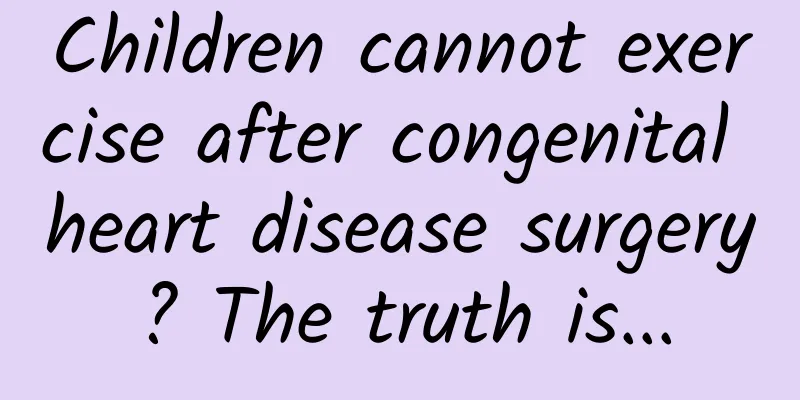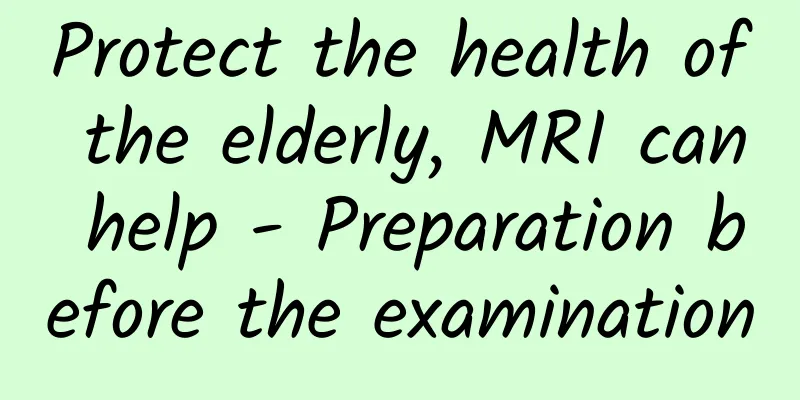Children cannot exercise after congenital heart disease surgery? The truth is...

|
"My child has undergone congenital heart disease surgery and cannot exercise. He needs to rest." "He cannot do strenuous exercise such as running after congenital heart disease surgery." "My child has undergone congenital heart disease surgery and will be exempted from physical education classes in the future." ... Are these statements correct? Congenital heart disease is a common birth defect in my country, and surgery is currently the main treatment method. When these children are recovering from surgery, most parents are most concerned about whether their children should exercise? How should they exercise? Some parents believe that the trauma of heart surgery is so severe that they cannot exercise and need to rest; some parents believe that after exercise, the wound on the child's heart will not heal well and increase the burden on the heart... It can be seen that there are still some misunderstandings among parents about whether they can exercise after heart surgery. Today, we will interpret the physical activities of children after heart surgery. Myth 1: Children with congenital heart disease need to rest after major surgery and cannot exercise at all This is a very common misunderstanding. Many people do not have enough knowledge about physical activity and mistakenly believe that long-term rest is required to restore cardiac function after heart surgery. Therefore, they often restrict children's activities, causing them to be sedentary, lack exercise, be overweight, and have reduced cardiopulmonary exercise tolerance. In addition, children with congenital heart disease generally have delayed motor development. In the past, it was believed that this was mainly related to the disease and perioperative complications, but now it is believed that this may also be related to lack of activity. Congenital heart disease surgery is mainly to correct the abnormal heart structure of children. A large number of studies and clinical practices have shown that appropriate physical activity after congenital heart disease surgery is more helpful than bed rest to improve myocardial contractility and improve heart function. It can also improve the child's skeletal muscle, blood vessels and immune system function, prevent obesity, and improve psychological, cognitive and social functions. Since we want to get children moving, how long should they exercise every day? The exercise and activity guidelines for congenital heart disease in various countries have given a clear answer to this question. Children with congenital heart disease who have undergone radical surgery or do not need subsequent treatment should avoid being sedentary for more than 2 hours and engage in at least 60 minutes of physical activity every day, at least 3 days a week. Parents can choose appropriate activities based on this activity principle, the age of the child, and different developmental stages. For example, infants and young children aged 0-2 years old should focus on growth and development, and parents can try to do some pleasant and safe parent-child activities; preschool children should focus on developing motor skills, and parents can let their children participate in daily housework, cycling, ball games, and group activities; children and adolescents should focus on muscle training and resistance exercises, such as dance, aerobics, ball games, etc. Myth 2: Children cannot participate in running after surgery for congenital heart disease. This is also a misunderstanding of many people. In fact, the key to whether you can run lies in the level of heart function after surgery. Running is one of the simplest forms of exercise. It can effectively improve heart function, enhance heart contraction and relaxation, and the density of cardiac capillaries, and improve heart regulation. The subtle effects of running may be difficult to detect, but heart rate, an important indicator of heart function, can be monitored by wearable technology. For example, when we are at rest, our heart rate begins to drop; when we exercise, our heart rate rises. A person who runs regularly has a significantly lower heart rate at rest than a person who does not exercise, which prolongs the diastole of the heart and gives the heart more time to return blood and fill up, preparing for the next contraction. Therefore, children who run regularly and scientifically will have better cardiopulmonary function. However, after congenital heart disease surgery, children cannot run at a high intensity, otherwise it will increase health risks. Scientific running is the key. Usually, we use metabolic equivalents (METs) to divide the intensity of children's physical activities into: METs values <3 for low-intensity activities, 3-5.9 for moderate-intensity activities, and ≥6 for high-intensity activities. According to the METs values of energy consumption of physical activities in children and adolescents, the METs values of different physical activities are different. Taking running as an example, jogging for children aged 6-9 is 5.5METs (moderate intensity), while sprinting can reach 7.2METs (high intensity). It can be seen that the METs values of running at different paces are different, and it does not belong to the concept of strenuous exercise. Therefore, parents can set a suitable running speed for their children according to their cardiopulmonary function level, and exercise from slow to fast, step by step, so as to achieve the purpose of cardiac rehabilitation. Myth 3: Children with congenital heart disease cannot attend physical education classes after surgery and should be exempted from physical education classes. This view is incorrect. Because children with congenital heart disease have congenital malformations and delayed growth and development, their cardiopulmonary function is indeed different from that of children of the same age, and their aerobic metabolism capacity is relatively low. Therefore, many parents will overprotect their children and limit the amount of outdoor activities for children after surgery. It has become a normal practice to exempt them from physical education classes. In fact, limiting physical education classes will not only affect children's physical development and cardiopulmonary function, but also isolate them from society and cause psychological problems such as depression. So, how can we let children participate in physical education classes safely? In clinical practice, a simple classification is usually made based on the type of congenital heart disease and the surgical situation. For example, asymptomatic children with non-cyanotic congenital heart disease can attend physical education classes as usual after surgery, without restrictions on recreational activities and competitive sports; while children with cyanotic congenital heart disease or after palliative surgery need to complete a cardiac function assessment before deciding whether they can attend physical education classes. Generally speaking, the level of cardiac function can be assessed through routine cardiac ultrasound examinations, but this static cardiac state cannot present hidden problems during exercise, leading to the risk of myocardial ischemia, arrhythmia, etc. in children during daily exercise. In recent years, pediatric cardiac rehabilitation clinics can assess children's dynamic cardiac function levels through cardiopulmonary exercise testing (CPET). CPET is a maximum exercise test. Children need to wear electrocardiogram patches, blood oxygen saturation probes, and blood pressure monitors, and also wear masks to obtain oxygen intake and carbon dioxide emissions during exercise. Through these dynamic data, CPET can simultaneously observe the stress response of the cardiovascular and respiratory systems of children to the same exercise, and objectively, quantitatively, and comprehensively evaluate cardiopulmonary reserve function and exercise endurance. This means that parents can get a definite answer as to whether children with congenital heart disease can take physical education classes after surgery and how much exercise they should do. It can be seen that the traditional concept of "resting" disease rehabilitation model is not completely correct, especially not suitable for children who are in the growth and development process after congenital heart disease surgery. Parents should pay attention to the importance of physical activity for disease rehabilitation and take their children to the pediatric cardiac rehabilitation clinic for dynamic and static assessment. It is believed that after implementing scientific and step-by-step cardiac rehabilitation prescriptions, children's cardiopulmonary function will continue to improve. It should be known that only when children can run and jump freely, talk and laugh with their peers, and play together, can they achieve true health. Author: Chief Nurse of Cardiothoracic Surgery, Shanghai Children's Medical Center, Shanghai Jiao Tong University School of Medicine Review | Professor Zhang Yaqing, PhD Supervisor, School of Nursing, Shanghai Jiao Tong University, Director of the Institute of Nursing Management, China Hospital Development Institute, Shanghai Jiao Tong University Tang Qin Director of the Science Popularization Department of the Chinese Medical Association National Health Science Popularization Expert Illustration: Yan Sinian, a graduate student at the School of Nursing, Shanghai Jiao Tong University |
<<: Can irradiated food be eaten safely?
>>: 5 simple habits that can make your brain smarter
Recommend
Can I have sex if I have HPV infection?
HPV is a relatively common viral infection, which...
What causes abdominal pain due to less menstruation?
Menstruation is an important sign of sexual matur...
Female ureaplasma dna positive
Gynecological diseases are taboo for female frien...
Blood like leucorrhea during menstruation
Menstruation is a very normal physiological pheno...
How to maintain health during the Bailu solar term? What to eat during the Bailu solar term
Bailu is a typical autumn climate. As the saying ...
What are the consequences of not resting after an abortion?
Abortion is very harmful to women's bodies, s...
Can women practice yoga at home?
Yoga is a preferred exercise method among many fe...
Does laser hair removal affect menstruation?
As people pay more attention to their appearance,...
How painful is it to be broken?
Many female friends are very afraid of their virg...
Pregnant woman gets up too fast and the fetus fractures
There are many things that women need to pay atte...
How to maintain ovaries for 45-year-old women
Women should take good care of themselves, whethe...
How much money can a pair of OK lenses save after centralized procurement? Here are the things parents should pay attention to
Produced by | Eye Health is Real Author | Chen Zh...
World Kidney Day | "Silent Thief" - Dent disease that "steals" kidney function
If your child has unexplained foamy urine, recurr...
What's wrong with having a period every 20 days?
Women's menstrual cycle has a certain regular...
Can I eat grapefruit? Why do I need to eat grapefruit to promote ovulation?
Grapefruit is rich in vitamins. When ripe, the pe...









